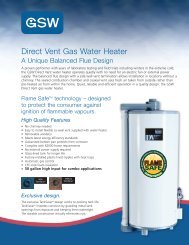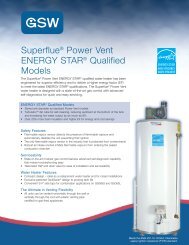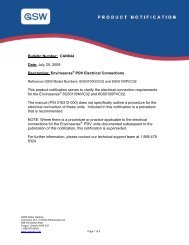Download PDF - GSW Water Heating
Download PDF - GSW Water Heating
Download PDF - GSW Water Heating
Create successful ePaper yourself
Turn your PDF publications into a flip-book with our unique Google optimized e-Paper software.
IV) OPERATION<br />
Temperature Adjustment<br />
WARNING:<br />
Risk of scalding<br />
There is a hot water scald potential if the<br />
thermostat is set too high.<br />
The National Plumbing code requires that the temperature<br />
of residential electric service water heaters be set at 60°C<br />
(140°F) (Canada), 49°C (120°F) (U.S.A.). The maximum<br />
outlet temperature of some bath fixtures must be tempered<br />
to 49°C (120°F) to reduce risk of scalding. Higher temperatures<br />
increase the risk of scalding. The thermostats operate<br />
automatically. They can be adjusted to provide warmer or<br />
cooler water temperature. Set both thermostats to the<br />
SAME setting (if applicable).<br />
If water temperature adjustment is required:<br />
1. Turn the electrical supply to the water heater "OFF".<br />
2. Remove the access door(s) and insulation pad(s).<br />
3. Check with a voltage tester at terminal 1 and 3 of the<br />
limit control that power is indeed "OFF".<br />
4. Adjust the thermostat(s) to the water temperature<br />
desired (if a two-thermostat system exists, set both thermostats<br />
at the same temperature).<br />
5. Ensure insulation pad is in the door cavity. Replace<br />
access door(s).<br />
6. Turn the electrical supply to the water heater "ON".<br />
<strong>Water</strong><br />
Temperature<br />
Time for 1st Degree<br />
Burn (Less Severe<br />
Burns)<br />
Temperature Limit Control<br />
For safety, a non-adjustable high limit temperature switch<br />
will shut off the power when excessive water temperatures<br />
are reached. This switch must be re-set manually. See<br />
“Trouble-Shooting” section.<br />
V) MAINTENANCE<br />
Time for Permanent<br />
Burns 2nd & 3rd<br />
Degree (Most Severe<br />
Burns)<br />
44°C (110°F)<br />
(normal shower<br />
temp.)<br />
47°C (116°F) (pain threshold)<br />
47°C (116°F) 35 minutes 45 minutes<br />
50°C (122°F) 1 minute 5 minutes<br />
55°C (131°F) 5 seconds 25 seconds<br />
60°C (140°F) 2 seconds 5 seconds<br />
65°C (149°F) 1 second 2 seconds<br />
68°C (154°F) instantaneous 1 second<br />
(U.S. Government Memorandum, C.P.S.C., Peter L.<br />
Armstrong, Sept. 15,1978)<br />
Temperature & Pressure Relief Valve<br />
Manually operate the temperature and pressure relief valve<br />
at least once a year to make sure it is working properly and<br />
that there are no blockages. To prevent water damage, the<br />
valve must be properly connected to a discharge line that<br />
terminates at an adequate drain. Standing clear of the<br />
outlet (discharged water may be hot), slowly lift and<br />
release the lever handle on the temperature and pressure<br />
relief valve (see Figure 3) to allow the valve to operate freely<br />
and return to its closed position. If the valve fails to completely<br />
reset and continues to release water, immediately<br />
turn "OFF" the electrical supply to the tank, and close the<br />
cold water supply valve and call a qualified service technician.<br />
In systems where the relief valve discharges periodically,<br />
this may be due to thermal expansion causing pressure<br />
build up. See “Pressure Build-Up (Thermal<br />
Expansion)” section.<br />
CAUTION<br />
The out-flowing water is hot. Avoid splashing<br />
the water on yourself or on the surroundings<br />
where it may cause damage.<br />
TEMPERATURE AND<br />
PRESSURE RELIEF VALVE<br />
DISCHARGE LINE TO DRAIN<br />
Figure 3 T&P Relief Valve Test<br />
MANUAL RELIEF VALVE<br />
WARNING<br />
Electrical Shock Hazard<br />
Disconnect power before<br />
servicing. Replace all parts<br />
and panels before operating.<br />
Failure to do so can result in<br />
death or electrical shock.<br />
Element Replacement<br />
1. See “Draining the Tank” section to remove water from<br />
the heater.<br />
2. Turn the electrical supply to the water heater "OFF".<br />
3. Remove the access door(s) and insulation pad(s).<br />
4. Disconnect wires from heating element terminals.<br />
5. Unscrew the element using a 1-1/2 in. socket wrench or<br />
tool number S1008, available from your water heater<br />
distributor.<br />
6. Replace element with new one, taking care that sealing<br />
gasket is in the groove of element flange.<br />
7. Re-connect wiring, and replace Di-Electric shields.<br />
8. Ensure insulation pad is in the door cavity. Replace<br />
access door(s).<br />
9. Fill tank with water BEFORE turning ELECTRICITY on.<br />
See “Filling the Tank” section.<br />
– 7 –





